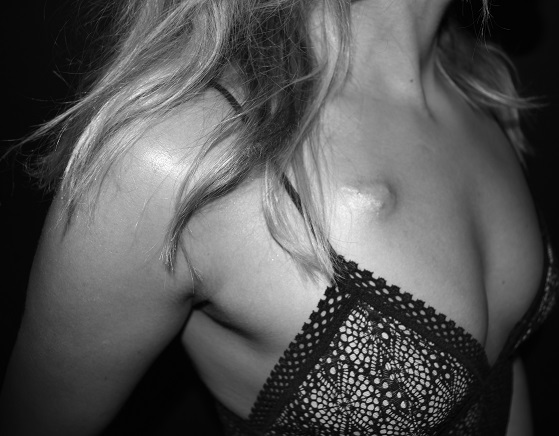Exposing Myself: I Have a Port, And I Am Proud of My Body.

{source}
This is the right time. This is the delicate piece that cystic fibrosis has aggressively sculpted in the last 28 years.
This is a body working against itself and for itself, all within the same breath. This is a God-given body, altered by medical professionals with one mission in mind: to keep it alive. This is me.
Needles, syringes, and IV’s are limbs. Nurses and doctors are family. Hospitals are home.
In February of 2013, I made an on-the-spot decision to have a port-a-cath inserted into my chest. At the time, I had just been admitted into the hospital for a lung infection, or what us CFers call, a tune-up.
Usually, within the first day of being admitted, a team of specialized nurses would visit me in my hospital room, dope me up on Versed, and insert a PICC (Peripherally Inserted Central Catheter) just above my elbow on my inner arm, threading it through my vein until it reached the outside of my heart.
If you have ever had a PICC inserted without mild sedatives, I commend you.
Once the PICC was in place, doctors would start me on heavy duty antibiotics. A PICC is helpful because the antibiotics are administered quickly through the bloodstream. After about a week in the hospital, I’d be sent home to continue two to three more weeks on home IV’s. Once my health improved and my lung function confirmed that, the PICC would be removed, much more easily than the process of insertion.
However, during this particular visit in the hospital, nurses could not find a proper vein to insert the PICC. Even after ultrasounds performed on both arms, my veins were deemed either almost invisible or too scarred from previous PICCs. When told this, I immediately panicked. My nurses left my room to discuss other options with my doctors.
One of the nurses came back into my room with news that my doctors had ordered a port-insertion scheduled for the following morning. Then, without hesitation, asked if I’d prefer it to be inserted into my armpit or chest. I quickly shouted , “Chest!” The thought of a needle in my armpit freaked me out. My nurse explained more about the type of port I was going to be getting, then left my room. I was in tears.
My stepdad had been in my room the entire time and witnessed it all. He was excited for me and immediately tried to lift my spirits by listing all the reasons why this port-insertion would be so great for me. “You won’t have to get a new PICC for each round of IV antibiotics. A port is going to be so much easier for nurses to access. Yadda, yadda, yadda…” It went in one ear and out the other.
I had seen ports before and I had seen the eyesore of scars that ports have left. I wanted no part of that, ever. Plus, until this time, I had never looked sick. With a port, I wouldn’t be able to hide my disease. I’d have to start answering questions. I’d look less attractive. My femininity would be stripped from me. All of these thoughts devastated me.
That night, alone in my room, I wheeled my IV pole over to the mirror above the bathroom sink and undressed. I stared at myself and touched my chest as tears rolled down my cheeks. This was the last time I’d see such a feminine part of me untouched by cystic fibrosis. I took a mental picture, dressed back up, and went to sleep.
It’s been five years since my port was inserted. The first year with it was quite troublesome. More so because of the emotional pain it brought. And yes, even though it is quite a small change on my body, it has taken a large toll on my ego and pride. I’ve been shocked at some of the comments, remarks, and questions that I have received about my port.
It goes to show that when people see something out of the ordinary, they assume. No, it doesn’t hurt. No, it isn’t a cyst. No, it isn’t a third nipple. Yes, I’ve been asked all of these questions a handful amount of times and it’s disappointing and hurtful.
I have good days where I choose to expose it and feel confident when I answer questions as to why I have a port, or what it even is. I also have days where I choose to cover it with clothing simply because I don’t feel like showing it or talking about it. I try to stay proud of my body, embrace my port, and love it, even though some days I hate it.
This article is meant to educate the individuals who do not know what a port is, have never seen one, or assume it’s something it surely is not. I am hoping that exposing what seems to be so minor will shed major light upon this small mechanism in my body.
***
At six months old, Alexis Smith was diagnosed with the genetic disease, cystic fibrosis (CF). At the time of her diagnosis, the average life expectancy of someone with the disease was 18. Her family was told they’d be lucky to see her graduate high school. Now, 28 years later, Alexis is thriving. Each day is an uphill battle, but she has learned to embrace her illness, even at its most terrifying moments. In 2012, she became an advocate for the Cystic Fibrosis Foundation (CFF), whose mission is to raise awareness and ultimately find a cure for the disease. Facing her illness has never been easy. As a child, Alexis developed anxiety, and has struggled with bouts of severe depression. Writing has always been her most therapeutic outlet. She believes in the power of self-expression and the serendipitous bonds we form when sharing our most personal stories. No one walks alone. You could contact Alexis via her website, Instagram or Facebook.
***
{Join us on Facebook, Twitter, Instagram & Pinterest}

